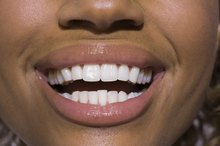Sensodyne Vs. Close Up Toothpaste
Americans spend more than $1.6 billion a year on toothpaste, according to the website HealthNews – and most toothpastes contain more or less the same ingredients. Comparing Sensodyne and Close-up is a little like comparing apples and oranges anyway because they are each designed to do different things. Close-up, the first toothpaste to contain mouthwash, was introduced in 1967 to improve your breath and brighten your teeth. Sensodyne is specifically formulated to be kinder to sensitive teeth. It is also more expensive than Close-up, and the American Dental Association has not approved it.
Tooth Sensitivity
If your teeth are sensitive, it is likely because you have exposed dentin, according to Sensodyne’s website. Dentin is porous, so whatever toothpaste you use can theoretically seep down through those little holes to get to the tooth nerve. Sensodyne coats and protects the nerve once it reaches it. But it can take several weeks and many brushings to achieve this, according to the website ConsumerSearch. Close-up does not make any claims about being gentler for sensitive teeth.
- If your teeth are sensitive, it is likely because you have exposed dentin, according to Sensodyne’s website.
Key Ingredients
What Is the Difference Between Dental Bonding & Veneers?
Learn More
In addition to the properties that can coat tooth nerves, Sensodyne has now introduced iso-active Foaming Gel. It contains isopentane, a hydrocarbon that makes the toothpaste foam so it can penetrate areas of your mouth where your toothbrush might not be able to reach. Its Pronamel version reportedly possesses ingredients that can harden your enamel and protect it against acidic foods and beverages. Close-up's key ingredients are glycerin and alcohol – the same active ingredients in mouthwash. Close-up also claims to contain a whitening system, but HealthNews points out that research has provided no evidence that any toothpaste actually works to lighten or eliminate tooth stains.
- In addition to the properties that can coat tooth nerves, Sensodyne has now introduced iso-active Foaming Gel.
- Close-up also claims to contain a whitening system, but HealthNews points out that research has provided no evidence that any toothpaste actually works to lighten or eliminate tooth stains.
Abrasiveness
The abrasive ingredient in toothpastes is sodium lauryl sulfate, according to ConsumerSearch. Sensodyne does not contain it, although some consumers have reported that Sensodyne irritates their gums anyway. Close-up does contain sodium lauryl sulfate and HealthNews reports that it is one of the most abrasive toothpastes on the market. An abrasive toothpaste can scrub away tooth enamel, which is a permanent condition.
- The abrasive ingredient in toothpastes is sodium lauryl sulfate, according to ConsumerSearch.
- Sensodyne does not contain it, although some consumers have reported that Sensodyne irritates their gums anyway.
Cavity-Fighting Capabilities
Side Effects of Whitening With Carbamide Peroxide
Learn More
Both Sensodyne and Close-up contain sodium monofluorophosphate, a form of flouride that prevents cavities and fights tooth decay.
Taste
ConsumerSearch indicates that some users have found the taste and texture of Sensodyne to be unpleasant 2. Comparatively, Close-up bills itself as tasting great-tasting, and many consumers seem to agree.
Related Articles
References
Writer Bio
Beverly Bird has been writing professionally since 1983. She is the author of several novels including the bestselling "Comes the Rain" and "With Every Breath." Bird also has extensive experience as a paralegal, primarily in the areas of divorce and family law, bankruptcy and estate law. She covers many legal topics in her articles.









